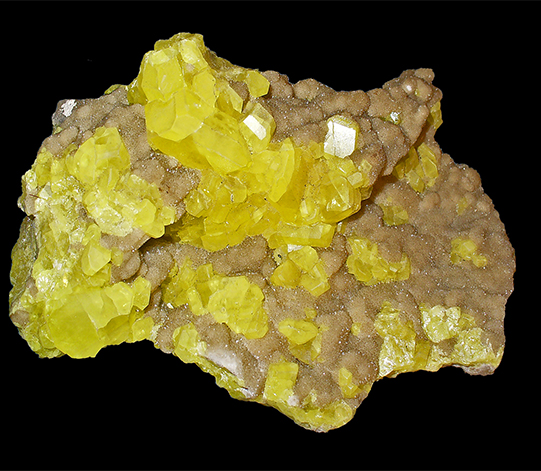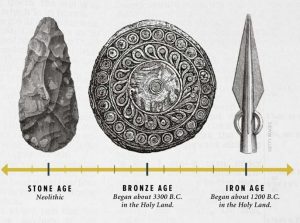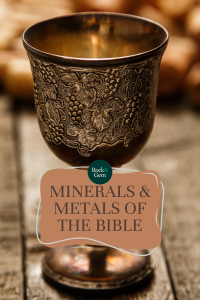
Minerals and metals in the Bible are referenced more than 1,700 times, using such familiar terms and phrases as “fire and brimstone,” “pieces of silver,” “copper from the rock,” “salt of the earth,” and “jars of clay.” It is interesting to consider these minerals and metals in the Bibe not in their scriptural contexts, but from the perspectives of history, geology and Biblical archaeology.
Minerals and Metals in the Bible: Timeline
 Biblical archaeologists study ancient cultural sites and artifacts to gain insight into the Bible’s Old and New Testaments. Combining archaeology with scriptural interpretation provides a clearer understanding of life as it was and the events that occurred during the biblical period, which extends from 3300 B.C. to the first century A.D.
Biblical archaeologists study ancient cultural sites and artifacts to gain insight into the Bible’s Old and New Testaments. Combining archaeology with scriptural interpretation provides a clearer understanding of life as it was and the events that occurred during the biblical period, which extends from 3300 B.C. to the first century A.D.
Archaeologists divide biblical history into three general periods based on the dominant material used in tools and weapons: Stone Age, Bronze Age and Iron Age.
Holy Land Topography
The Jordan Rift Valley dominates the Holy Land’s topography. This rift system began forming 35 million years ago with a westward separation of the African tectonic plate from the Asian plate and fractured the crust into long, parallel faults. The crust between the faults subsided, sometimes thousands of feet, to create a long, linear sequence of narrow rift valleys. The East African Rift System, including the Jordan Rift Valley, is still widening today.
The Jordan Rift Valley extends from Lebanon south for 300 miles to the Gulf of Aqaba. Within it is the Jordan River, the Sea of Galilee, the Dead Sea and the desolate Wadi Araba, all features of biblical significance.
Main Metals in the Bible

The Bible mentions six metals: gold, silver, lead, tin, copper, and iron. Although not mined in the Holy Land, gold and silver played major roles in biblical history. The Bible mentions gold more than 400 times and silver nearly 300 times.
Metals in the Bible – Gold
During the biblical period, just as today, gold served as a store of value, a symbol of wealth and prominence, and a jewelry metal. It was obtained in trade mainly from sources in Egypt, the Arabian Peninsula, India, and the Sinai Peninsula.
Metals in the Bible – Silver
Silver was scarce in the Holy Land until the Greeks developed the great Laurion silver-lead mines in the fourth century B.C. Silver coins such as Greek drachmas and staters, Roman denarii (the Bible’s “tribute pennies”) and Tyrian shekels, were the standard mediums of exchange throughout the greater biblical region.
Metals in the Bible – Lead
There are also large amounts of lead which, in the Holy Land, served as rebar in the construction of stone buildings. Holes drilled through adjoining stone blocks were filled with molten lead which then solidified to secure the blocks in place.
Metals in the Bible – Copper
Copper had a great impact on the Holy Land and is one of the main metals in the Bible. Most copper came from the Timna Valley in Wadi Araba near Eilat, modern Israel’s southernmost city on the Gulf of Aqaba. Timna Valley copper occurs as both sulfide and oxide minerals that are emplaced in granite, dolostone and sandstone. Pre-dynastic Egyptian cultures were mining these rich deposits as early as 4000 B.C. Miners initially collected nodules of copper minerals from the surface; later, they followed outcrops underground to carve out large systems of passageways and galleries.
Biblical scholars have long debated how Solomon, the fabulously rich king of Israel from 970 to 930 B.C., amassed his fortune. Many believed that Solomon owned gold mines. But in the 1930s, an American archaeologist suggested that the legendary “King Solomon’s Mines” were the Timna Valley copper mines, an idea initially discredited because the ruins, at that time, could not be dated to Solomon’s reign.
But in 2013, Israeli archaeologists accurately carbon-dated organic remains from the Timna Valley ruins to 930 B.C. — the end of the great king’s reign. Most biblical scholars now agree that copper from the Timna Valley, the world’s earliest example of systematic copper mining, was indeed the source of Solomon’s wealth. Today, the valley, a remote, arid region of spectacular pillars, arches, and canyons, is the site of Timna Valley Park and an adjacent nature preserve. Exhibits at the park museum represent 6,000 years of copper mining.
Metals in the Bible – Iron
Thanks to supplies of Timna Valley copper and Kestel tin, the Bronze Age dawned in the Holy Land about 3300 B.C. Bronze, a copper-tin alloy superior to copper in hardness, durability, and workability, was the primary metal for tools and weapons for the next two millennia. (Many Bible translations erroneously refer to bronze as “brass,” which is a modern copper-zinc alloy.)
About 1500 B.C., the Hittite Empire in Anatolia began smelting iron from bog iron ores. Described in the Old Testament as adversaries of the Israelites, the Hittites produced tempered, carbon-steel alloys that were harder and more durable than bronze, and could be fashioned into sharper-edged weapons. Iron weapons, armor and chariots, the latter a landmark military advancement, soon made the Hittites a feared regional power.
The Hittites zealously guarded their iron-smelting methods. When their empire collapsed around 1250 B.C., Hittite ironworkers scattered throughout the greater Mediterranean region to bring the Iron Age to various regional cultures. By 1200 B.C., iron, obtained from hematite and magnetite deposits in Syria, Anatolia and Wadi Araba, was in widespread use throughout the Holy Land.
Metals in the Bible – Tin
The world’s first great source of tin was Kestel in the Taurus Mountains of Anatolia (now south-central Turkey), where the mining of placer and vein deposits of cassiterite or tin dioxide began about 3400 B.C. Caravans traded this tin throughout the Middle East and beyond. The Kestel ruins contain miles of narrow tunnels and dozens of small smelters that reduced cassiterite to metallic tin.
Minerals and Metals in the Bible – The “Eilat Stone”

The national stone of Israel, “Eilat stone,” also known as “King Solomon’s stone,” consists of intergrowths of blue-green masses of azurite, malachite, chrysocolla and turquoise. Specimens and polished cabochons of Eilat stone have been popular souvenirs of Israel since the nation was founded in 1948. But the specimen supply ended when the last commercial copper mine closed in the 1980s. Since then, much Eilat stone sold in Israel and abroad is similarly colored material from the copper mines of Africa and Arizona.
Main Minerals in the Bible
Minerals in the Bible – Alabaster
Another carving material was alabaster, a dense, fine-grained, compact form of gypsum, or hydrous calcium sulfate, which often occurs in limestone formations. Translucent and often displaying subtle patterns of honey-yellow colors, alabaster is soft and easily carved. Polishing brings out a warm glow similar to that of marble. Alabaster was fashioned into goblets, sculptures, vases, and funerary urns. (Some “alabaster” artifacts from the biblical period consist of the travertine form of calcium carbonate, which has a similar appearance.)
Minerals in the Bible – Soapstone

Stone carvers also worked with soapstone or steatite. Soapstone, a metamorphic rock consisting primarily of talc, or hydrous magnesium silicate, is the softest mineral at Mohs 1.0. It has a “soapy” feel and colors ranging from off-white to grays, blues, browns, and greens. The softest and most desirable carving grades contain about 80 percent talc. Soapstone artifacts from the Holy Land include bottle stoppers, cylinder seals, beads, and figurines. Most of this soapstone came from metamorphic formations in the mountains of present-day Syria and Turkey.
Minerals in the Bible – Brimstone
The Bible mentions brimstone 14 times, always as an idiomatic expression for the wrath of God, as in “fire and brimstone.” The English word “brimstone” is derived from the Old English brynstan, literally meaning “burning stone,” referring to its ability to burn in air. Brimstone is elemental sulfur that frequently occurs in volcanic environments, hence the Old Testament’s association with fire, hell, and God’s retribution. In biblical times, sulfur had many uses in medicine, and as a fumigant and disinfectant.
Sulfur occurs at several sites in the Jordan Rift Valley which, like all rifts, has numerous remnant volcanic fumaroles and active thermal springs, some with condensate and evaporite sulfur deposits.
Minerals in the Bible – Limestone
Two common, often-overlooked mineral resources of great importance in biblical history are limestone and clay. Much Holy Land bedrock is limestone, a marine sedimentary rock consisting of at least 50 percent calcium carbonate. Limestone forms when calcareous skeletal and shell remains of marine life accumulate on sea bottoms, mix with other sediments and lithify into massive formations.
Jerusalem rests atop thick formations of fossiliferous, fine-grained, oolitic limestone with buff, pink, green and brown colors. Since the city was permanently settled around 3000 B.C., this late-Cretaceous Period limestone, now known as “Jerusalem stone,” has been used in much of Jerusalem’s construction.
Jerusalem stone was also the raw material for making lime or calcium oxide. Finely ground stone was calcined (heated) to drive off the carbon dioxide from the contained calcium carbonate, leaving behind white lime.
Multicolored limestone mosaics were a popular art form in the Holy Land during the Roman occupation. Stoneworkers cut colored limestone into thin, half-inch-square, inlay pieces to create elaborate mosaics for interior décor.
Minerals in the Bible – Salt
It’s not surprising that the Bible refers to salt (halite, sodium chloride) more than 30 times. During the biblical period, salt was a widely traded commodity that was used as a food seasoning and preservative, a disinfectant, a ceremonial offering, and even a monetary-like unit of exchange. The Holy Land’s main source of salt was the Dead Sea, which is fed by the Jordan River and has no outlets. Continuous, rapid evaporation in the desert climate maintains the salinity of the Dead Sea at 34 percent, nine times higher than that of seawater. Thick shoreline salt encrustations were the first regional sources of salt.
By 1000 B.C., the systematic mining of rock salt had begun at Jebel Usdum (Mount Sodom) on the Dead Sea’s northwest coast. Jebel Usdum is a five-mile-long, 720-foot-high ridge consisting almost entirely of layers of rock salt that formed 10 million years ago when seawater repeatedly flooded the deepening Jordan Rift Valley and then evaporated. Mining peaked in the second century B.C. when camel caravans regularly transported tons of rock salt to distant markets.
At the southern end of the Jebel Usdum ridge, a 100-foot-tall spire of rock salt is known as “Lot’s wife,” alluding to the Old Testament account of the destruction of the cities of Sodom and Gomorrah in which Lot’s wife, while fleeing the city of Sodom, ignored God’s warning not to look back and was turned into a pillar of salt.
Minerals in the Bible – Pitch
Another Dead Sea resource was pitch, or natural asphalt, which is referred to in the Old Testament when God instructs Noah to build an ark and “cover it inside and outside with pitch.” This pitch originated as bituminous (hydrocarbon-rich) limestone. The heat and pressure of deep burial altered the bitumen into partially developed petroleum that mixed with silt and clay, lost its volatile components and formed thick layers of natural, black asphalt. Parts of the Dead Sea floor consist of layers of pitch that sometimes floated to the surface where they were collected, cut into pieces, and shipped to markets.
During the biblical period, most of this so-called “Dead Sea stone” was sold to Mediterranean shipyards as hull-caulking material. Some was traded to Egypt where it was used to waterproof papyrus boats and to Mesopotamia to serve as building mortar. Because high bitumen pitch burned like coal, it was also used as a fuel. Solid, black pieces of pitch, similar in density, color, and carving properties to jet, were fashioned into ornaments.
Minerals in the Bible – Natron

The Bible also mentions “nitre” or natron (sodium carbonate decahydrate), which was used as a soap, antiseptic, disinfectant, food preservative and medicinal compound. Some natron was obtained from the Dead Sea, but most came from northeast Egypt’s huge Wadi el Nutrun (Natron Valley) evaporite deposit. Utilizing its hygroscopicity, the Egyptians employed natron extensively in mummification.
By 1000 B.C., natron’s most important use was in making glass, or “crystal” in the biblical terminology. Glass, which was then very valuable and even served as a gemstone, was made from silica sand, a lime stabilizer and a natron flux to lower the silica’s melting point.

By the first century B.C., new glassblowing techniques could create thin-walled glass vessels in virtually any shape. During the Roman occupation of the Holy Land, glassmakers began producing high-refraction glass by adding lead oxide to the glass mix to increase density and thus refractive index and brilliance.
Minerals in the Bible – Clay
Clay was another common mineral resource of great importance in biblical history. Wet clay has a plastic consistency and is easily moldable. It is mixed with various tempering or stabilizing materials, then fired in ovens where it dries, loses its plasticity, and hardens into permanent, molded ceramics.

By the early biblical time, making ceramics had become a well-developed skill and art that produced pottery, storage vessels, funerary urns, beads, ceremonial objects and writing tablets. Writers used styli to impress characters into soft, wet clay which was then fired into durable tablets.
Many priceless biblical artifacts have survived within ceramic jars. One of the best-known examples came to light in 1947 when a Bedouin herdsman discovered caves in the limestone cliffs along the northwestern shore of the Dead Sea. These caves contained ceramic jars holding one of the 20th century’s greatest archaeological discoveries—the Dead Sea Scrolls. The scrolls are written mostly on parchment, with a few inscribed on papyrus and one on a copper sheet. Without the protection of clay jars, archaeologists believe none of the scrolls would have survived.
Biblical Gemstones
Along with minerals and metals in the Bible, the Bible also mentions gemstones, notably those of the sacred breastplate of the high priest of the Israelites. Familiarly known as “Aaron’s breastplate” or the “breastplate of judgment,” this golden breastplate was set with 12 different gemstones representing the 12 tribes of Israel and dates roughly to the 14th century B.C.
The Old Testament describes the breastplate and its gemstones in detail. But over many centuries as the original ancient Hebrew text was translated into Greek, Aramaic, Latin and, finally, English, the gemstone identities have become uncertain.
New interpretations of Old Testament scripture combined with modern archaeological and mineralogical data, along with historical information about the availability and sources of specific gem materials during the early biblical period, is providing new ideas about the identity of the breastplate gemstones.
This story about minerals and metals in the Bible previously appeared in Rock & Gem magazine. Click here to subscribe. Story by Steve Voynick.














